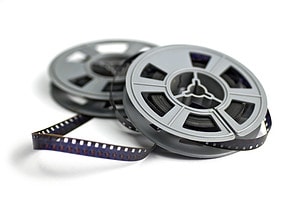 The 8mm film is a cine film format released in 1965 by Eastman-Kodak, as the successor of the older “Double” or “Regular” 8mm film. Unlike its predecessor, the 8mm film was no longer a 16mm strip divided into two 8mm strips, but a plain 8mm strip. Thanks to narrower perforation holes, the 8mm film provided a frame size of 4.01mmx5.36mm, whereas Regular 8 only reached 3.28mmx4.37mm. Furthermore handling Super 8 systems was easier than with its predecessors: the tapes were supplied as cartridge that were inserted into the camera. This eliminated the need for careful handling when inserting and changing film.
The 8mm film is a cine film format released in 1965 by Eastman-Kodak, as the successor of the older “Double” or “Regular” 8mm film. Unlike its predecessor, the 8mm film was no longer a 16mm strip divided into two 8mm strips, but a plain 8mm strip. Thanks to narrower perforation holes, the 8mm film provided a frame size of 4.01mmx5.36mm, whereas Regular 8 only reached 3.28mmx4.37mm. Furthermore handling Super 8 systems was easier than with its predecessors: the tapes were supplied as cartridge that were inserted into the camera. This eliminated the need for careful handling when inserting and changing film.
Originally, Kodak, Fuji and Agfa planned to develop an 8mm format by the time of the Olympic Games in Tokyo (1964) as a joint project. The product was to be called Rapid 8. But Kodak left the group prematurely and published the previous results as its own development under the name Super 8. Fuji tried to counter with its own further development of the project under the name Single 8. However, this format was never able to establish itself.
Most 8mm films are silent films. Although there was the possibility of recording sound with a separate recorder, it was extremely complicated to synchronise film and sound track.
Reel sizes
The different reel sizes of the films:
| Reel diameter | Film length | Film duration at 18 fps | Film duration at 24 fps |
|---|---|---|---|
| 74mm | 15m | 3,5 min | 2,5 min |
| 93mm | 30m | 6,5 min | 6 min |
| 127mm | 60m | 13 min | 10 min |
| 147mm | 90m | 20 min | 15 min |
| 177 mm | 120m | 26 min | 20 min |
| 206mm | 180m | 40 min | 30 min |
| 248mm | 250m | 55 min | 42 min |
Durability
This cine film format has only a limited durability. The film material is extremely sensitive and reacts easily to environmental influences. If not stored properly, the following damage can occur:
- Dryness makes the tapes brittle. They can break and your recordings will be severely damaged.
- Light causes fading of your 8mm films. If your films are not stored in the dark, they will fade. The light from a projector can also have this effect, when used frequently.
- Dust contaminates and causes scratches to the material. If your films get dusty, the particles become lodged between the rolled-up layers of film, scratching the film during playback.
- Humidity and high temperatures can trigger the vinegar syndrome. If your cine films are acetate films, they are particularly sensitive. They can be affected by the vinegar syndrome, which can spread to other films and thus render entire collections unusable. In addition, mould can form in high humidity.
Save memories with MEDIAFIX
To preserve your recordings permanently and pass them on safely to future generations, there is only one thing to do: have your 8mm films digitised! MEDIAFIX converts your recordings with a best-price-guarantee, from £9.99/reel.
Other than preserving your cine films in its current states, you also get additional conveniences. Digitised 8mm films can be viewed conveniently on TV, computer, tablet or projector screen. This saves you the hassle of setting up a projector and screen. Once scanned, you can also easily share your Super 8mm films with friends and family! Only a few clicks and your sister in Australia will receive your shared childhood memories by email.
Do you have any questions? Our friendly customer service will be happy to advise you in a personal conversation.
Simply call 020 3904438-0
Our phone hours are:
Mon-Fri 10.00 a.m. - 3.00 p.m.


